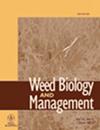加纳北部花生生产中植物密度和品种对产量、叶斑病、杂草种类丰富性和多样性的影响
IF 1.5
4区 农林科学
Q3 AGRONOMY
引用次数: 0
摘要
植株密度低和杂草丛生是加纳北部花生生产面临的主要挑战。为了确定种植密度和品种对谷物和饲料产量、叶斑病发病率、杂草种类多样性和生物量的影响,进行了一项为期两年的农场研究。研究采用了 6 个品种和 4 种种植密度的因子处理组合,条带小区设计,4 次重复。这些品种是(早熟型:早熟型:中国、Yenyewoso、Samnut 23;晚熟型:Azivivi、Manipint:Azivivi、Manipinta、Samnut 22)。植株密度分别为 9、11、15 和 22 株/平方米。晚熟品种的冠层覆盖率、谷物和饲料产量均高于早熟品种(p < .05)。与早熟品种相比,晚熟品种的莎草杂草种类频率、密度和叶斑病发病率也最低。冠层覆盖率、谷物和饲料产量随着植株密度的增加而增加。阔叶杂草种类频率和密度、杂草生物量、丰富度和多样性随着种植密度的增加而下降。谷物产量与阔叶杂草种类频率、密度和杂草生物量呈显著负相关。研究结果表明,在加纳北部和西非类似的农业生态环境中,早熟和晚熟花生品种的种植密度均为 22 株/平方米,可提高谷物和饲料产量,减少杂草种类的丰富度、多样性和生长量。本文章由计算机程序翻译,如有差异,请以英文原文为准。
Plant density and variety effect on yield, leaf spot disease, weed species richness and diversity of groundnut production in northern Ghana
Low plant density and weed infestation are major challenges for groundnut production in northern Ghana. A two‐year on‐farm study was conducted to determine the effect of plant density and variety on grain and fodder yields, incidence of leaf spot disease, weed species diversity and biomass. A factorial treatment combination of 6 varieties and 4 plant densities laid in strip plot design with 4 replications was used. The varieties were (early maturity type: Chinese, Yenyewoso, Samnut 23 and late maturity type: Azivivi, Manipinta, Samnut 22). The plants density included 9, 11, 15 and 22 plants/m2 . The late maturity varieties recorded higher (p < .05) canopy cover, grain and fodder yields relative to that of the early maturity varieties. The late maturity varieties also recorded the least sedge weed species frequency, density and incidence of leaf spot disease compared with that of the early maturity varieties. The canopy cover, grain and fodder yields increased with increasing plant density. Broadleaf weed species frequency and density, weed biomass, richness, and diversity declined with increasing plant density. Grain yield showed negative and significant correlation with broadleaf weed species frequency, density and weed biomass. The results suggest that both early and late maturity groundnut varieties can be planted at a density of 22 plants/m2 to increase grain and fodder yields and reduce weed species richness, diversity and growth in northern Ghana and similar agro‐ecology in West Africa.
求助全文
通过发布文献求助,成功后即可免费获取论文全文。
去求助
来源期刊

Weed Biology and Management
农林科学-农艺学
CiteScore
2.70
自引率
0.00%
发文量
13
审稿时长
>36 weeks
期刊介绍:
Weed Biology and Management is an international journal, published four times per year. The journal accepts contributions in the form of original research and review articles in all aspects of weed science. Contributions from weed scientists in the Asia–Pacific region are particularly welcomed.
The content of the contributions may relate to weed taxonomy, ecology and physiology, weed management and control methodologies, herbicide behaviors in plants, soils and environment, utilization of weeds and other aspects of weed science. All contributions must be of sufficient quality to extend our knowledge in weed science.
 求助内容:
求助内容: 应助结果提醒方式:
应助结果提醒方式:


